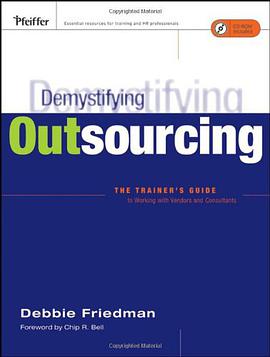

具體描述
Over the past decade, credit derivatives have emerged as the key financial innovation in global capital markets. At end 2004, the market size hit $6.4 billion (in notional amounts) from virtually nothing in 1995. This rise has been spurred by the imperative for banks to better manage their risks, not least credit risks, and the appetite shown by institutional investors and hedge funds for innovative, high yielding structured investment products. As a result, growth in collateralized debt obligations and other second-generation products, such as credit indices, is currently phenomenal. It is enabled by the standardization and increased liquidity in credit default swaps - the building block of the credit derivatives market. Written by market practitioners and specialists, this book covers the fundamentals of the credit derivatives and structured credit market, including in-depth product descriptions, analysis of real transactions, market overview, pricing models, and banks business models. It is recommended reading for students in business schools and financial courses, academics, and professionals working in investment and asset management, banking, corporate treasury and the capital markets. Highlights include: written by market practitioners and specialists with first-hand experience in the credit derivatives and structured credit market; a clearly-written, pedagogical book with numerous illustrations; detailed review of real-case transactions; and a comprehensive historical perspective on market developments, including up-to-date analysis of the latest trends.
著者簡介
圖書目錄
1.1 Credit Risk.
1.1.1 Definition and Typology of Credit Risk.
1.1.2 Characteristics of Credit Risk.
1.1.3 The Importance of Credit Risk in Capital Markets.
1.2 Assessment and Measurements of Credit Risk.
1.2.1 Bank Capital Adequacy Standards (Basel I).
1.2.2 Credit Risk Analyzed by Rating Agencies.
1.2.3 Credit Risk Measured in the Financial Markets: CreditSpread.
1.3 Traditional Methods of Credit Risk Management and theEmergence of Credit Derivatives.
1.3.1 Traditional Methods for Managing Credit Risk (IssuerRisk).
1.3.2 Counterparty Risk Management in Derivatives Markets.
1.3.3 Emergence and Advantages of Credit Derivatives.
2 Typology of Credit Derivatives and their MainApplications.
2.1 Credit Default Swaps.
2.1.1 Description of Credit Default Swaps.
2.1.2 Comparison Between the CDS Market and the Cash Market:Basis.
2.1.3 Main Variations on CDSs.
2.2 Other Credit Derivatives.
2.2.1 Credit Spread Derivatives.
2.2.2 Synthetic Replication Products.
2.3 Main applications of Credit Derivatives.
2.3.1 Applications for Institutional Investors and Other CapitalMarket players.
2.3.2 Credit Derivative Applications in Bank Management.
2.3.3 Credit Derivative Applications for Corporates.
3 Second-Generation Credit Derivatives.
3.1 Basket Credit Default Swaps.
3.1.1 First-to-Default Credit Swaps.
3.1.2 Concrete Example.
3.1.3 Extension of the First-to-Default Principle: i toj-to-Default Products.
3.2 Hybrid Products.
3.2.1 Capital-Guaranteed/Protected Products.
3.2.2 Other Hybrid Products.
3.2.3 Concrete Example of a Transaction.
3.3 Credit Indices.
3.3.1 Introduction to Credit Indices.
3.3.2 Credit Index Mechanism, Pricing and Construction.
3.3.3 iTraxx Indices: a True Innovation to BenefitInvestors.
4 Collateralized Debt Obligations.
4.1 Cash-Flow CDOs (Arbitrage CBOs and CLOs).
4.1.1 Origin of Arbitrage CBOs/CLOs.
4.1.2 Description of a CDO Structure.
4.1.3 Overview of the CBO/CLO Market and RecentDevelopments.
4.2 Balance Sheet-Driven CDOs.
4.2.1 Securitization of Bank Loans.
4.2.2 The Impact of Credit Derivatives: Synthetic CLOs.
4.2.3 Balance Sheet-Driven CDOs and Regulatory Arbitrage.
4.3 Arbitrage-Driven Synthetic CDOs.
4.3.1 The First Arbitrage-Driven Synthetic CDOs.
4.3.2 Actively Managed Arbitrage-Driven Synthetic CDOs.
4.3.3 On-Demand CDOs (Correlation Products).
5 The Credit Derivatives and Structured Credit ProductsMarket.
5.1 Overview of the Market.
5.1.1 Main Stages in the Development of the Credit DerivativesMarket.
5.1.2 Size, Growth and Structure of the Credit DerivativesMarket.
5.1.3 Size, Growth and Structure of the CDO Market.
5.2 Main Players.
5.2.1 Banks.
5.2.2 Insurance, Reinsurance Companies and FinancialGuarantors.
5.2.3 Hedge Funds and Traditional Asset Managers.
5.2.4 Corporates.
5.3 At the Heart of the Market: The Investment Banks.
5.3.1 Position of the Investment Banks in the Credit DerivativesMarket.
5.3.2 Position of the Investment Banks in the CDO Market.
5.3.3 Functions and Organization of Investment Banks.
6 Pricing Models for Credit Derivatives.
6.1 Structural Models.
6.1.1 The Black–Scholes Option Pricing Model.
6.1.2 Merton’s Structural Model of Default Risk(1976).
6.1.3 Limitations and Extensions of the Merton Model (1976).
6.1.4 Pricing and Hedging Credit Derivatives in StructuralModels.
6.2 Reduced-Form Models.
6.2.1 Hazard Rate and Credit Spreads.
6.2.2 Pricing and Hedging of Credit Derivatives in Reduced-FormModels.
6.2.3 Accounting for the Volatility of Credit Spreads.
6.2.4 Accounting for Interest Rate Risk.
6.3 Pricing Models for Multi-Name Credit Derivatives.
6.3.1 Correlation, Dependence and Copulas.
6.3.2 The Gaussian Copula Model.
6.3.3 Multi-Asset Structural Models.
6.3.4 Dependent Defaults in Reduced-Form Models.
6.4 Discussion.
6.4.1 Comparing Structural and Reduced-Form ModelingApproaches.
6.4.2 Complex Models, Sparse Data Sets.
6.4.3 Stand-alone Pricing Versus Marginal Pricing.
7 The Impact of the Development in CreditDerivatives.
7.1 The Impact of the Growth in Credit Derivatives on BankingInstitutions.
7.1.1 Far-Reaching Changes in the Capital Markets.
7.1.2 An Economic Approach to Credit Risk Management.
7.1.3 Overview of the Banks of the Twenty-First Century: theEffect of Credit Derivatives on Banks’ Strategy, Organizationand Culture.
7.2 Credit Derivatives and Financial Regulations.
7.2.1 Credit Derivatives and the New Basel II Regulations.
7.2.2 Credit Derivatives and the Instability of the FinancialSystem.
7.2.3 A More Rounded Picture.
7.3 Credit Derivatives: A Financial Revolution?
7.3.1 Introduction to Particle Finance Theory.
7.3.2 Implications of ‘Particle Finance Theory’ forthe Capital Markets.
7.3.3 An Innovation that Heralds Others.
· · · · · · (收起)
讀後感
評分
評分
評分
評分
用戶評價
提供新的金融創新的思路。外國人寫的書,結構較中國人嚴謹。
评分提供新的金融創新的思路。外國人寫的書,結構較中國人嚴謹。
评分提供新的金融創新的思路。外國人寫的書,結構較中國人嚴謹。
评分提供新的金融創新的思路。外國人寫的書,結構較中國人嚴謹。
评分提供新的金融創新的思路。外國人寫的書,結構較中國人嚴謹。
相關圖書
本站所有內容均為互聯網搜索引擎提供的公開搜索信息,本站不存儲任何數據與內容,任何內容與數據均與本站無關,如有需要請聯繫相關搜索引擎包括但不限於百度,google,bing,sogou 等
© 2025 book.quotespace.org All Rights Reserved. 小美書屋 版权所有




















